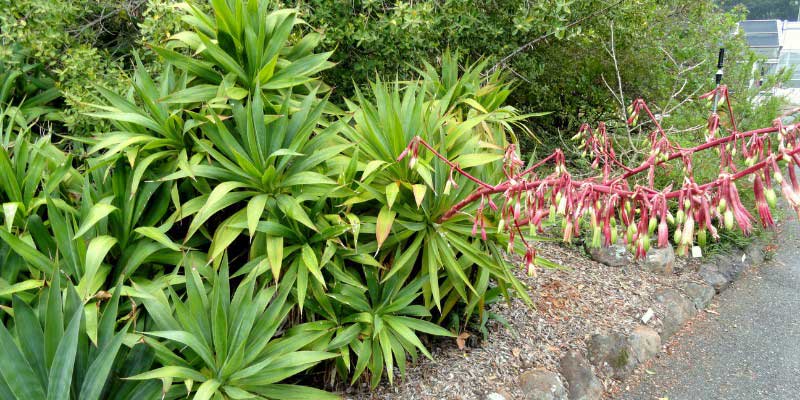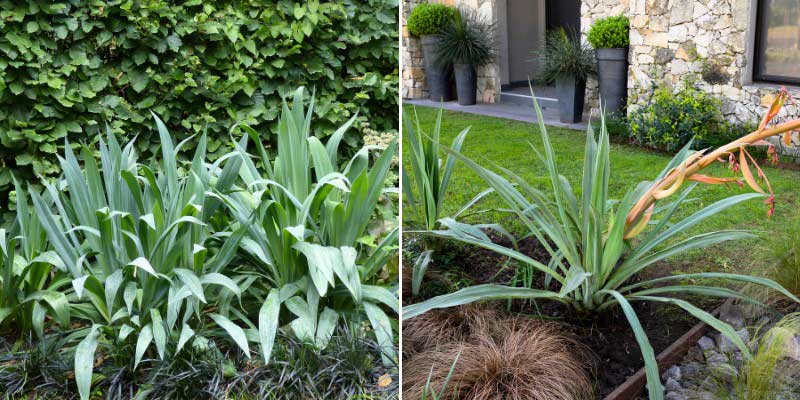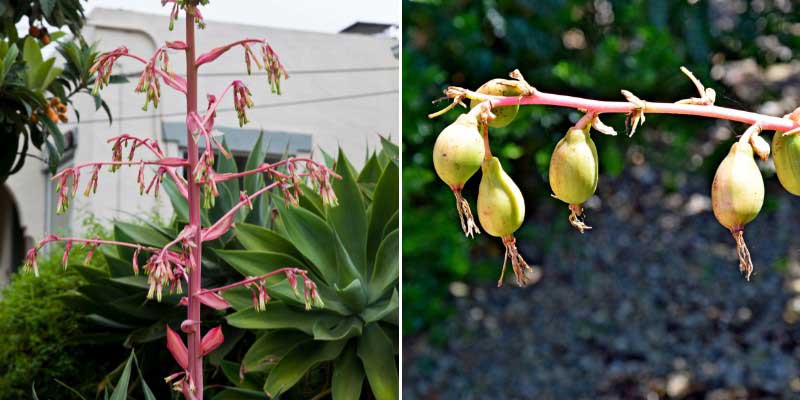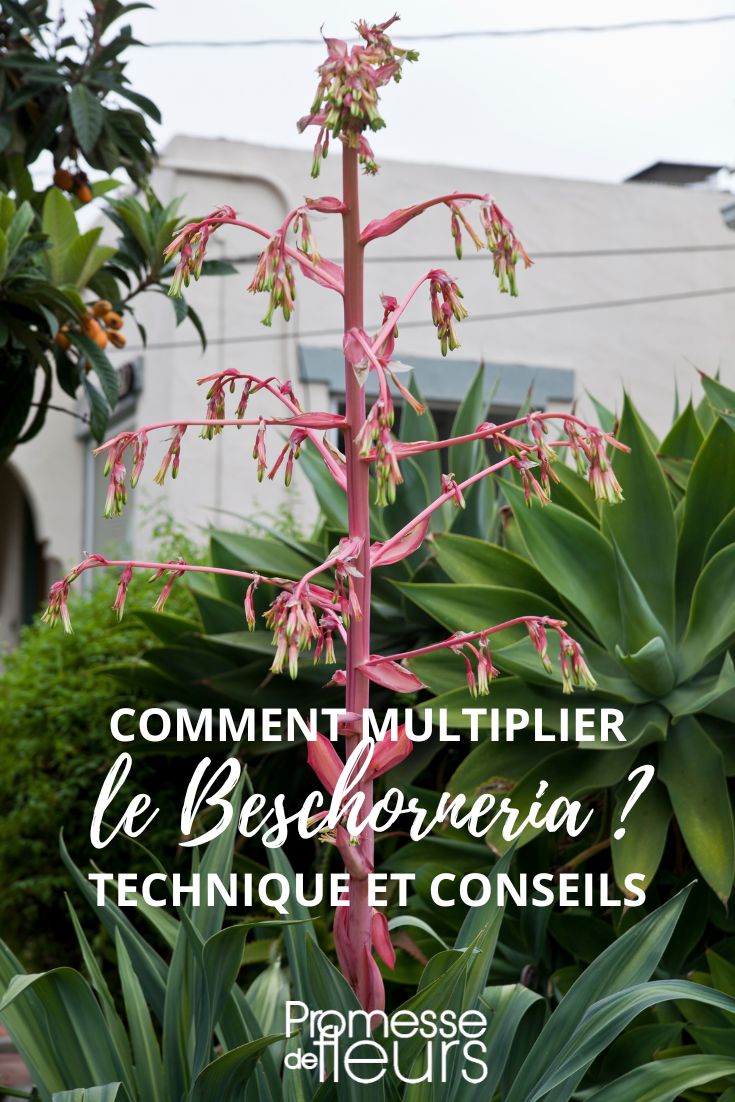With its elegant rosettes and spectacular summer flowering, Beschorneria or Mexican lily is such an enticing plant that one inevitably wants to propagate it. After flowering, this succulent, exotic perennial related to agaves and Yucca naturally produces well-developed suckers around the main rosette, offering an excellent opportunity for propagation. It benefits from division when it begins to grow well. Sowing is also possible. Here is how to multiply it in the garden and thus obtain new young plants!
Why propagate Beschorneria?
Beschorneria thickens over the years thanks to its rootstocks, which produce numerous suckers all around the initial rosette. These small peripheral rosettes will flower in turn in following years, ensuring offspring. And, as Beschorneria produces suckers generously, it can become invasive if it thrives; division therefore helps to preserve the plant while limiting its spread. Depending on species (such as Beschorneria albiflora), flowers then turn into dehiscent capsules containing seeds that can be sown, making propagation by sowing also feasible.

Method 1: by division
When to divide Beschorneria?
Division of Beschorneria suckers is done in spring, from March to April, when young rosettes are well formed and large enough to be transplanted. It is carried out when mother plant is well rooted, usually after 3–4 years of cultivation. Be patient, as lifted rosettes will take several years before flowering.
Required equipment:
- A spade or fork
- A watering can
- A pruning shear or a knife that is sharp and disinfected
- Gravel, garden soil, river sand
- If planting in pots: pots, potting compost for Mediterranean plants, grit or clay pebbles
How to divide Beschorneria?
After planting, keep compost slightly moist during the first weeks, then reduce watering once plants show signs of establishment. Beschorneria prefers well-drained soil and tolerates excess water poorly. Rosettes can take time to establish, but with patience you will soon see vigorous new shoots. You can also spread a mineral mulch of pumice to keep soil cool and return heat during the night around young rosettes.

Method 2: by sowing
Sowing is a longer and more delicate method than dividing suckers, but it allows production of a large number of young plants from seeds to propagate this species. However, it is unpredictable, as results are not always true to the parent plant and failures are common.
When to sow Beschorneria?
Harvest seeds from a plant that has flowered, then sow them in late winter, in February–March.
Required equipment
- Pots or a seed tray
- Seed compost
- Sand
- A spray bottle

How to sow Beschorneria?
Here are the steps to succeed at sowing Beschorneria:
- After flowering, flowers produce seeds. Harvest them when ripe and dry.
- In pots or a seed tray, mix seed compost with a little sand to improve drainage.
- Sow seeds on surface of substrate, spacing them slightly. Cover with a thin layer of compost.
- Moisten substrate with a spray bottle to avoid displacing seeds.
- Place seed tray in a warm, bright spot at 21 °C, sheltered from direct sun.
- Maintain constant humidity without waterlogging the substrate.
- Germination can take a few weeks to a few months. Be patient and check substrate moisture regularly.
- When seedlings have developed several leaves, prick them out into individual pots with well-draining compost before planting out in the garden the following year, late spring, ideally April–May.
After planting, keep compost slightly moist during the first weeks, then reduce watering once plants show signs of establishment. Beschorneria prefers well-drained soil and tolerates excess water poorly. Rosettes can take time to establish, but with patience you will soon see vigorous new shoots. You can also spread a mineral mulch of pumice to keep soil cool and return heat during the night around young rosettes.

Method 2: by sowing
Sowing is a longer and more delicate method than dividing suckers, but it allows production of a large number of young plants from seeds to propagate this species. However, it is unpredictable, as results are not always true to the parent plant and failures are common.
When to sow Beschorneria?
Harvest seeds from a plant that has flowered, then sow them in late winter, in February–March.
Required equipment
- Pots or a seed tray
- Seed compost
- Sand
- A spray bottle

How to sow Beschorneria?
Here are the steps to succeed at sowing Beschorneria:
- After flowering, flowers produce seeds. Harvest them when ripe and dry.
- In pots or a seed tray, mix seed compost with a little sand to improve drainage.
- Sow seeds on surface of substrate, spacing them slightly. Cover with a thin layer of compost.
- Moisten substrate with a spray bottle to avoid displacing seeds.
- Place seed tray in a warm, bright spot at 21 °C, sheltered from direct sun.
- Maintain constant humidity without waterlogging the substrate.
- Germination can take a few weeks to a few months. Be patient and check substrate moisture regularly.
- When seedlings have developed several leaves, prick them out into individual pots with well-draining compost before planting out in the garden the following year, late spring, ideally April–May.
After planting, keep compost slightly moist during the first weeks, then reduce watering once plants show signs of establishment. Beschorneria prefers well-drained soil and tolerates excess water poorly. Rosettes can take time to establish, but with patience you will soon see vigorous new shoots. You can also spread a mineral mulch of pumice to keep soil cool and return heat during the night around young rosettes.

Method 2: by sowing
Sowing is a longer and more delicate method than dividing suckers, but it allows production of a large number of young plants from seeds to propagate this species. However, it is unpredictable, as results are not always true to the parent plant and failures are common.
When to sow Beschorneria?
Harvest seeds from a plant that has flowered, then sow them in late winter, in February–March.
Required equipment
- Pots or a seed tray
- Seed compost
- Sand
- A spray bottle

How to sow Beschorneria?
Here are the steps to succeed at sowing Beschorneria:
- After flowering, flowers produce seeds. Harvest them when ripe and dry.
- In pots or a seed tray, mix seed compost with a little sand to improve drainage.
- Sow seeds on surface of substrate, spacing them slightly. Cover with a thin layer of compost.
- Moisten substrate with a spray bottle to avoid displacing seeds.
- Place seed tray in a warm, bright spot at 21 °C, sheltered from direct sun.
- Maintain constant humidity without waterlogging the substrate.
- Germination can take a few weeks to a few months. Be patient and check substrate moisture regularly.
- When seedlings have developed several leaves, prick them out into individual pots with well-draining compost before planting out in the garden the following year, late spring, ideally April–May.
It is easy to detach young rosettes to propagate:
- Carefully, use a garden fork to lift the sucker gently
- Dig widely and deeply enough to avoid damaging its roots
- Use a pruning shear to separate it from the mother plant
- Remove damaged or dead leaves. If roots are long, trim them slightly to promote establishment.
- Replant the sucker immediately in a light, well-draining substrate (for example a mix of potting compost, river sand and garden soil). For potting, prepare pots with compost and lay a good drainage layer at the bottom.
- Plant the Beschorneria sucker without burying the collar too deeply
- Water generously.
After planting, keep compost slightly moist during the first weeks, then reduce watering once plants show signs of establishment. Beschorneria prefers well-drained soil and tolerates excess water poorly. Rosettes can take time to establish, but with patience you will soon see vigorous new shoots. You can also spread a mineral mulch of pumice to keep soil cool and return heat during the night around young rosettes.

Method 2: by sowing
Sowing is a longer and more delicate method than dividing suckers, but it allows production of a large number of young plants from seeds to propagate this species. However, it is unpredictable, as results are not always true to the parent plant and failures are common.
When to sow Beschorneria?
Harvest seeds from a plant that has flowered, then sow them in late winter, in February–March.
Required equipment
- Pots or a seed tray
- Seed compost
- Sand
- A spray bottle

How to sow Beschorneria?
Here are the steps to succeed at sowing Beschorneria:
- After flowering, flowers produce seeds. Harvest them when ripe and dry.
- In pots or a seed tray, mix seed compost with a little sand to improve drainage.
- Sow seeds on surface of substrate, spacing them slightly. Cover with a thin layer of compost.
- Moisten substrate with a spray bottle to avoid displacing seeds.
- Place seed tray in a warm, bright spot at 21 °C, sheltered from direct sun.
- Maintain constant humidity without waterlogging the substrate.
- Germination can take a few weeks to a few months. Be patient and check substrate moisture regularly.
- When seedlings have developed several leaves, prick them out into individual pots with well-draining compost before planting out in the garden the following year, late spring, ideally April–May.
It is easy to detach young rosettes to propagate:
- Carefully, use a garden fork to lift the sucker gently
- Dig widely and deeply enough to avoid damaging its roots
- Use a pruning shear to separate it from the mother plant
- Remove damaged or dead leaves. If roots are long, trim them slightly to promote establishment.
- Replant the sucker immediately in a light, well-draining substrate (for example a mix of potting compost, river sand and garden soil). For potting, prepare pots with compost and lay a good drainage layer at the bottom.
- Plant the Beschorneria sucker without burying the collar too deeply
- Water generously.
After planting, keep compost slightly moist during the first weeks, then reduce watering once plants show signs of establishment. Beschorneria prefers well-drained soil and tolerates excess water poorly. Rosettes can take time to establish, but with patience you will soon see vigorous new shoots. You can also spread a mineral mulch of pumice to keep soil cool and return heat during the night around young rosettes.

Method 2: by sowing
Sowing is a longer and more delicate method than dividing suckers, but it allows production of a large number of young plants from seeds to propagate this species. However, it is unpredictable, as results are not always true to the parent plant and failures are common.
When to sow Beschorneria?
Harvest seeds from a plant that has flowered, then sow them in late winter, in February–March.
Required equipment
- Pots or a seed tray
- Seed compost
- Sand
- A spray bottle

How to sow Beschorneria?
Here are the steps to succeed at sowing Beschorneria:
- After flowering, flowers produce seeds. Harvest them when ripe and dry.
- In pots or a seed tray, mix seed compost with a little sand to improve drainage.
- Sow seeds on surface of substrate, spacing them slightly. Cover with a thin layer of compost.
- Moisten substrate with a spray bottle to avoid displacing seeds.
- Place seed tray in a warm, bright spot at 21 °C, sheltered from direct sun.
- Maintain constant humidity without waterlogging the substrate.
- Germination can take a few weeks to a few months. Be patient and check substrate moisture regularly.
- When seedlings have developed several leaves, prick them out into individual pots with well-draining compost before planting out in the garden the following year, late spring, ideally April–May.




































Comments